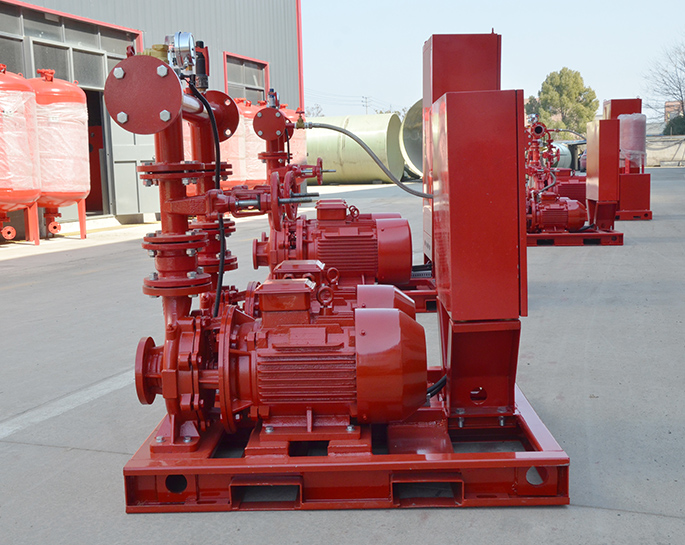Maintenance and maintenance and failure method between fire pumps and fire embolism pump systems
Feb 24, 2023
Share:
1. Maintenance of Fire Pump and Fire Embolism Pump System
a. Regularly check the running condition of the fire pump and fire embolism pump system;
b. Regularly inspect the pressure gauge, pressure switch, inlet and outlet valves, suction and discharge valves, and other components of the fire pump and fire embolism pump system;
c. Regularly check the transmission and control components of the fire pump and fire embolism pump system, such as couplings, belts, oil level, and lubrication;
d. Regularly check the electrical components of the fire pump and fire embolism pump system, such as wiring, motors, and switches;
e. Regularly inspect the piping of the fire pump and fire embolism pump system for any signs of leakage;
f. Regularly check the water tank of the fire pump and fire embolism pump system for any signs of corrosion or other damage;
g. Regularly inspect the water supply source for any signs of contamination or other problems;
h. Regularly check the relief valves and other components of the fire pump and fire embolism pump system;
i. Regularly inspect the fire pumps and fire embolism pump systems for any signs of corrosion, wear, or other damage;
j. Regularly check the bearings, seals, and other components of the fire pump and fire embolism pump system to ensure proper operation.
2. Failure Method of Fire Pump and Fire Embolism Pump System
a. If the fire pump and fire embolism pump system fails to start, check the electrical system first. If the electrical system is in good condition, then check the mechanical components of the system and make sure they are adequately lubricated;
b. If the fire pump and fire embolism pump system fails to stop, check the control system to make sure it is operating properly and adjust the settings if necessary;
c. If the fire pump and fire embolism pump system is not delivering water, check the suction and discharge valves and the pressure gauge for any signs of obstruction or damage;
d. If the fire pump and fire embolism pump system is not delivering enough water, check the pressure switch, the relief valve, and the pressure gauge for any signs of obstruction or damage;
e. If the fire pump and fire embolism pump system is not delivering water at the correct pressure, check the pressure switch, the relief valve, and the pressure gauge for any signs of obstruction or damage;
f. If the fire pump and fire embolism pump system is not delivering water at the right temperature, check the inlet and outlet valves, the piping, and the water tank for any signs of obstruction or damage;
g. If the fire pump and fire embolism pump system is not delivering water at the right flow rate, check the suction and discharge valves and the pressure gauge for any signs of obstruction or damage.

a. Regularly check the running condition of the fire pump and fire embolism pump system;
b. Regularly inspect the pressure gauge, pressure switch, inlet and outlet valves, suction and discharge valves, and other components of the fire pump and fire embolism pump system;
c. Regularly check the transmission and control components of the fire pump and fire embolism pump system, such as couplings, belts, oil level, and lubrication;
d. Regularly check the electrical components of the fire pump and fire embolism pump system, such as wiring, motors, and switches;
e. Regularly inspect the piping of the fire pump and fire embolism pump system for any signs of leakage;
f. Regularly check the water tank of the fire pump and fire embolism pump system for any signs of corrosion or other damage;
g. Regularly inspect the water supply source for any signs of contamination or other problems;
h. Regularly check the relief valves and other components of the fire pump and fire embolism pump system;
i. Regularly inspect the fire pumps and fire embolism pump systems for any signs of corrosion, wear, or other damage;
j. Regularly check the bearings, seals, and other components of the fire pump and fire embolism pump system to ensure proper operation.
2. Failure Method of Fire Pump and Fire Embolism Pump System
a. If the fire pump and fire embolism pump system fails to start, check the electrical system first. If the electrical system is in good condition, then check the mechanical components of the system and make sure they are adequately lubricated;
b. If the fire pump and fire embolism pump system fails to stop, check the control system to make sure it is operating properly and adjust the settings if necessary;
c. If the fire pump and fire embolism pump system is not delivering water, check the suction and discharge valves and the pressure gauge for any signs of obstruction or damage;
d. If the fire pump and fire embolism pump system is not delivering enough water, check the pressure switch, the relief valve, and the pressure gauge for any signs of obstruction or damage;
e. If the fire pump and fire embolism pump system is not delivering water at the correct pressure, check the pressure switch, the relief valve, and the pressure gauge for any signs of obstruction or damage;
f. If the fire pump and fire embolism pump system is not delivering water at the right temperature, check the inlet and outlet valves, the piping, and the water tank for any signs of obstruction or damage;
g. If the fire pump and fire embolism pump system is not delivering water at the right flow rate, check the suction and discharge valves and the pressure gauge for any signs of obstruction or damage.


.png)
.png)

.png)


